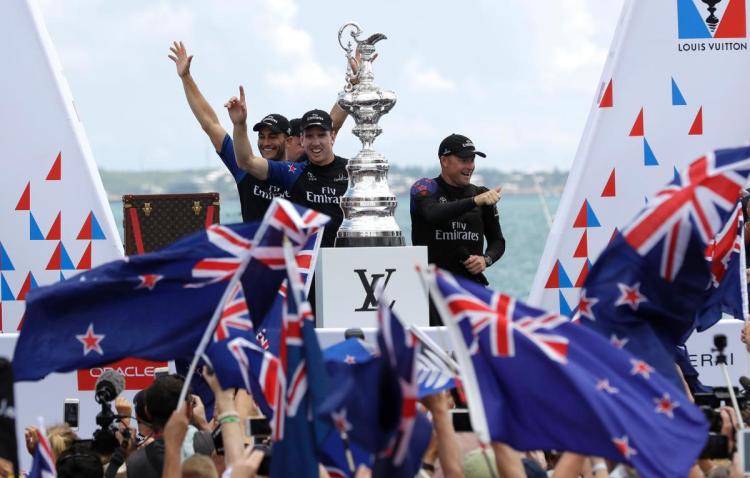
30 Jun America’s Cup Recap – All Hail the Kiwis!
Well the racing is over, the dust has settled, and we have a new America’s Cup champion: Emirates Team New Zealand. In stunning fashion, they crushed Oracle Team USA 7-1 in the finals to take the Auld Mug back to Auckland. You have to hand it to the Kiwis – they sailed almost flawlessly (with the pretty major exception of that dramatic capsize in the semi-finals) to earn the well-deserved win over Oracle, a team that was much better funded and had lots more practice time in Bermuda.
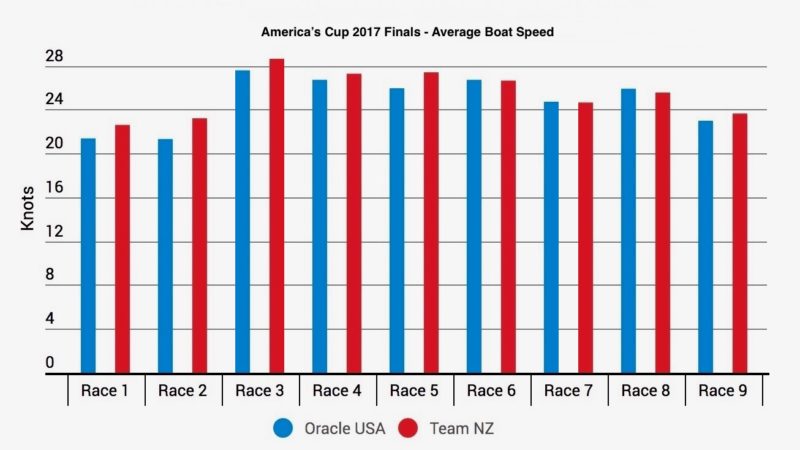
Team New Zealand clearly had faster boat speeds throughout the finals. Source: americascup.com
Much will be said and written about how and why New Zealand won with such a commanding performance. There are a few obvious things: their boat was demonstrably faster, and the cyclor innovation likely gave them an edge in terms of consistent power for their hydraulics. But there were other factors at work. Our America’s Cup recap teases out some of the more subtle things that contributed to their success.
Calculated risk-taking
After their fateful collapse in the 2013 America’s Cup finals, New Zealand knew they had to do things differently in order to win. Just like in a sailing race, you never have an opportunity to win if you only follow the leader around the course. The Kiwis took a number of calculated risks. One of the most obvious was using cycle power instead of grinders.
But even before that innovation was revealed, they replaced veteran helmsman Dean Barker with the young Peter Burling. Burling is a 420, 49er and Moth World Champion, but didn’t have America’s Cup experience. Team CEO Grant Dalton bet that Burling’s skill in high performance skiffs would translate well to the big AC50s. Burling had been racing since age 8, with 7 world championships and 2 Olympic medals under his belt, so Dalton had a hunch he could handle the pressure of high-profile America’s Cup racing. And his hunch was right – at age 26, Burling became the youngest helmsman to win the America’s Cup.
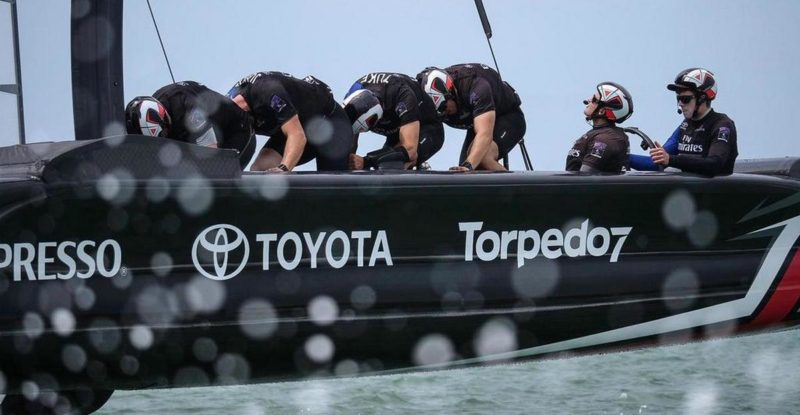
Young helmsman Peter Burling and the team of “cyclors” who provided pedal power for New Zealand’s AC50 foiling catamaran. Photo: Boats And Boats Magazine
Two other things stood out in terms of risk-taking. In a radical departure from the systems used by other teams, New Zealand set up their boat controls so they were distributed between several team members. On most teams the helmsman steers and controls the daggerboards. Because New Zealand’s pedal power allowed crew members to have their hands free, the skipper and wing trimmer also contributed to “flying” the boat, giving Burling the opportunity to focus on his strengths – driving and tactics.
In another departure from the America’s Cup norm, the Kiwis stayed in Auckland long after other teams established bases and began training in Bermuda. Many in the sailing world speculated this would be detrimental to Team New Zealand, missing out on their chance to assess the other teams in practice races. But it turned out to be an advantage. New Zealand was able to keep many of their innovations under wraps longer, leaving their competitors scrambling to catch up in the technology arms race.
Mateship, tall poppies and teamwork
Embedded in the New Zealand psyche is the concept of mateship. Loyalty to your friends and colleagues, especially in times of adversity, is a prized social value. And there is a general disregard for “tall poppies,” or people who think or act like they’re better than others. You could see both these concepts at work in the teamwork demonstrated by the Kiwis. Although he was often the face of the team, Burling consistently downplayed his role and emphasized the contributions of the other sailors, the shore team, support team, and management.
You even see this on the Emirates Team New Zealand website. The team page lists the team principal, board of directors, then everyone else – sailors, boat builders, engineers, shore crew, maintenance, trainers, cooks, admins and the CEO alike – grouped together under “Team” in alphabetical order. This directly reflects the Kiwi ethos of mateship, teamwork and fairness. No drama or prima donnas on this team.
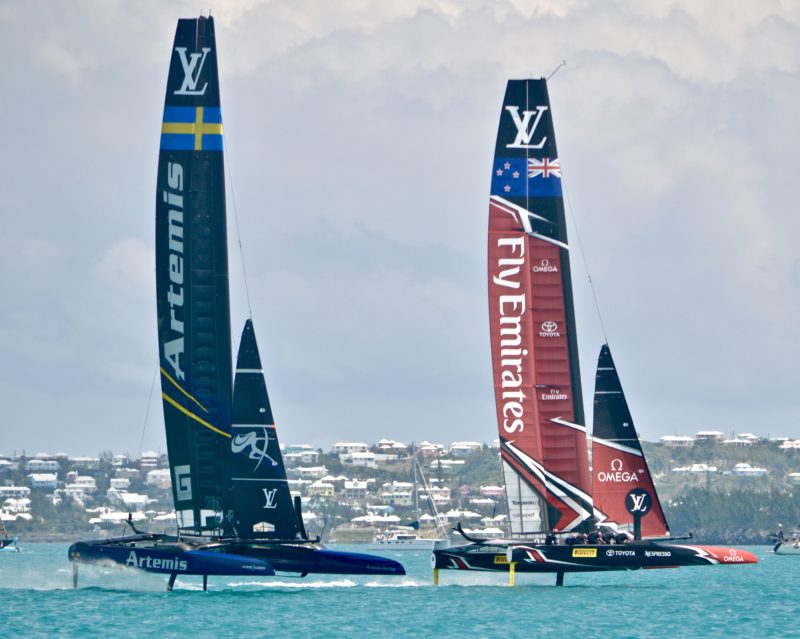
Team New Zealand defeated Artemis Racing in the semifinals 5-2. Photo: 12º West
This dynamic played out on the boat as well. Race commentators often noted how quiet the Kiwis were during races, compared to the steady chatter emanating from the other boats. For one thing, the distributed boat controls meant that the helmsman, skipper and trimmer had to work very closely to control the boat, and learn to trust each other’s instincts and reactions. I got the sense that the New Zealand team were so dialed in to each other’s thinking they just didn’t need to talk as much. A racing mentor once told me that “a quiet boat is a fast boat” – and this proved true of the Kiwis. They worked together intuitively, and seemingly effortlessly.
Kiwi pride
A success factor that cannot be discounted is the fierce Kiwi national pride carried by the team. A distinguishing feature of the New Zealand team is that all the sailors (save one) are Kiwis. A couple of other teams (particularly Land Rover BAR and Groupama Team France) also had a high percentage of nationals as sailors, but the New Zealand team had the most nationals across their entire organization.
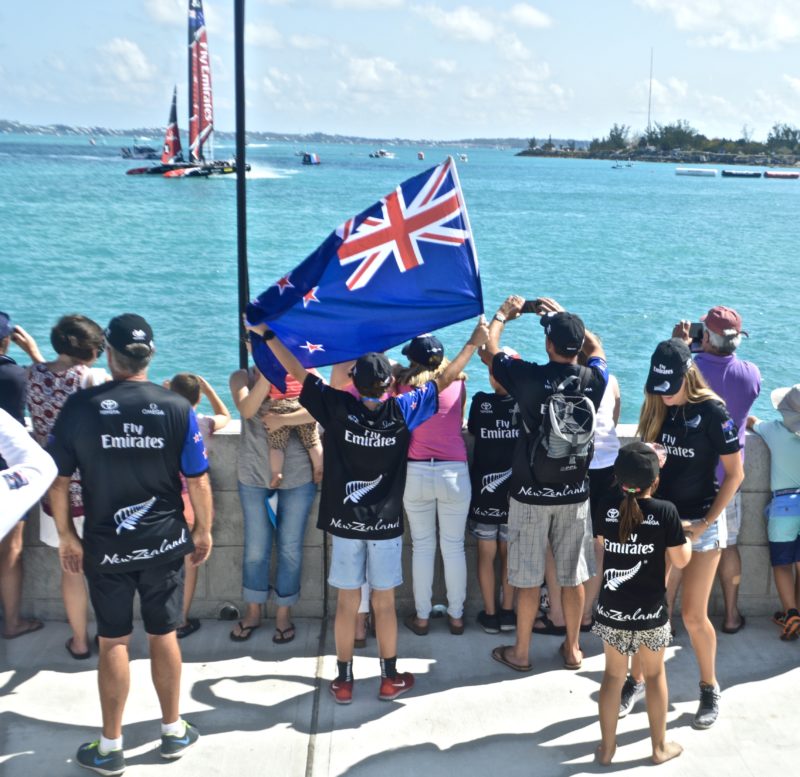
Lots of Kiwi fans made the long trek to Bermuda, while millions more were cheering from home. Photo: 12º West
New Zealand is a sports-mad country, to put it mildly. The sport of sailing gets more airtime there than most other places. Being an island nation, they have a deep connection to water; in New Zealand you are never more than 80 miles from an ocean or sea. There’s a strong sailing culture, and New Zealanders are known as world-class yacht designers and builders. Kiwis often dominate on the world yachting, kayaking, windsurfing and rowing scenes. It’s said that over 15% of New Zealand families own their own boats.
Emirates Team New Zealand surely knew there were carrying the hopes of 4.5 million Kiwis on their shoulders. In a reflection of national pride, the Kiwi boat was named Aotearoa – the Maori name for New Zealand that translates to “land of the long white cloud.” Although the America’s Cup races aired at 5 a.m. New Zealand time, many fans gathered each morning at watch parties to cheer on the team. In the America’s Cup Village in Bermuda, New Zealand flags were everywhere, borne by scores of Kiwi fans who had flown 24 hours or more to support Team New Zealand in person. The team and fans were united in one purpose: to bring the Auld Mug back to Auckland.
I have no doubt that the excellent New Zealand Maritime Museum (a must-visit when you’re in Auckland) is already updating their extensive America’s Cup exhibit to reflect the team’s recent victory.
And away we go
So that’s our America’s Cup recap, and our take on the not-so-obvious things we believe helped New Zealand win. What’s next? Already we know New Zealand will defend the Cup in Auckland, and that Italy’s Luna Rossa, representing Circolo della Vela Sicilia, will be the Challenger of Record. What we don’t know is when the next Cup will take place, and more importantly (and much more controversially) what type of boat will sail the race. Monohulls have been hinted at, but no one can say for sure what the future holds. However there is one prediction we’re pretty confident in: if New Zealand continues to innovate, take risks, and uphold Kiwi pride and tradition, they’ll be a formidable competitor for years to come.
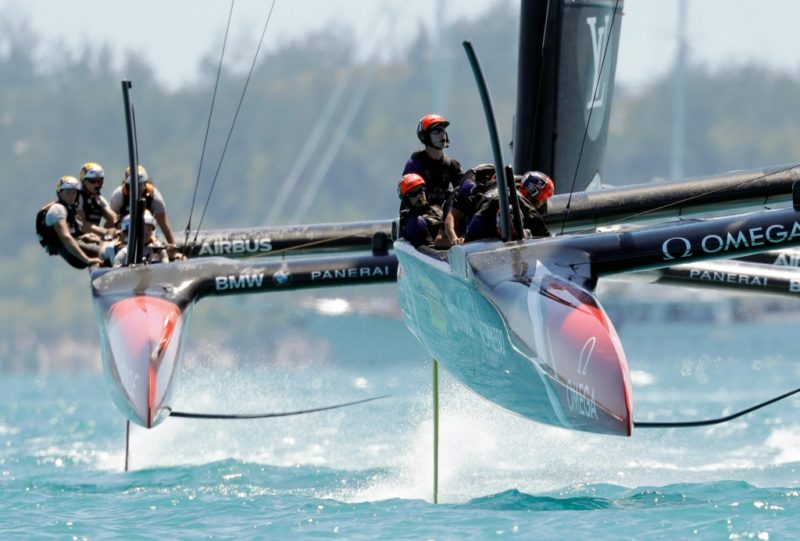
Emirates Team New Zealand in a familiar position – leading Oracle Team USA on the race course. Photo: ACEA
